005 - Sandwich Love
Top tips from one of London’s best bakers, the perfect sandwich loaf and how to fill it.
Thank you for subscribing to Food Team Monthly! This month, we went down to Bread Ahead to find out what makes their bread so much better than most of our attempts at home. Read on a little further for the ultimate sandwich bread, our favourite filling and an amazing way to use any leftovers. If you have always nearly nailed baking bread, need a couple of tips for how to go from good to great or don’t know where to start. We have you covered!
Slater: We were back at Borough Market. A lot had happened in the last 4 months, but Ginger Pig’s fabled sausage roll still tasted the same. True to form, Kush ate the lion’s share. When we had pitched the idea of a bread-based newsletter to Ebbers, he had instantly mentioned that it would be worth meeting Matthew Jones for a quick chat. Since opening his bakery Bread Ahead in 2013, Matthew had created a global brand that revolved around all things yeasted. Thus, we found ourselves hunched over flaky pastries round the corner from his flagship store, unfashionably early for a quick interview with the man himself.
Aside from a couple of weekend projects, bread didn’t feature too heavily in my cooking career. In the best restaurants, it was left to the experts who often came to work just before I went to sleep and left as I was finishing my morning prep jobs. Our only interaction would be a knowing glance as I looked up from podding peas, weary and covered in flour on their way out of the door. We would re-heat our morning pastries in the residual heat from the deck ovens they had used to bake the bread. I found that if a day-old croissant was first quickly dipped into water, then baked until crisp it would taste as good as new. Or good enough for my breakfast.
Bread only started to feature heavily in my cheffing career once it was all but over. I found work in a wood fired pizza restaurant in between jobs. There, I learnt how to mix, prove, manage and shape dough to produce hundreds of consistent pizzas no matter the temperature or humidity. I had thought that my stint as a pizza chef had given me a good bread background, until Kush showed me some of his lockdown creations.
Kush: I, unlike Slater, started baking at a very young age. My dad would spend hours on weekends making all manner of filled loaves and rolls that we would then turn into our picnic style lunches. Many years later I was fortunate enough to be able to spend time, whilst at Le Manoir, learning from Benoit Blin the Chef patissier who trained as a baker before retraining as a pastry chef in his native France. We used to serve 9 types of bread to the guests at the restaurant, baked twice a day, and as Slater said, the baking team would be the 1st in every day before anyone else had woken up.
I then moved to Bath and every Monday, the baker's day off at The Bath Priory, it was my job to make the bread for the hotel. This is where I really fell in love with baking and invested in a large Kenwood stand mixer for myself at home. From there it's been 11 years of trial and error, lots of research and geeking out on many hundreds of loaves to try and get the best bread possible out of my home oven!
Baking in lockdown, occupied a lot of my time as I started to experiment with sourdough and different styles of bread. I went from baking baguettes with a 70% hydration at the start of lockdown to attempting 110% hydration pan crystal in a quest to make the ultimate sandwiches. Safe to say my neighbours had a fresh loaf every day as I wanted to share my exploits and get their feedback.
When Ebbers mentioned that he knew Matthew from Bread Ahead I was so happy! Not only had I been eating their bread for many years, I had also served their bread and famous doughnuts at my 30th birthday so this was a perfect opportunity to connect with Matthew and also get his opinion on my own loaves!
Slater: Matthew took us through his sprawling bakery. While it was obvious he was a craftsman at heart, it was evident that the operation was process and detail-led. I reflected that while home bakers might not have to replicate results by the thousands on a daily basis, across various different continents like Matthew, close attention to detail can make all the difference. Details that might seem inconsequential at the time can transform good baking into great baking. All the way from ensuring consistent water temperatures, through to using the same type and crystal size of salt each time a loaf is made. This way, if small changes and adjustments are made deliberately, it’s easy to see the difference they make to the end product. This is vital for both learning in the long term and ensuring the best possible quality in the short term.
Matthew also left us with 5 tips of his own, so you can level up your bread game at home:-
Put the hours in and give it time. It’s a marathon not a sprint with bread and you aren’t going to get it bang on to start with. As with any craft, practice is paramount.
Focus on ingredients. Food only tastes as good as the ingredients you use and the same goes for baking. Bread Ahead uses local millers who mill local grains to get the best tasting bread possible. The same goes for the yeast, salt and water you use.
Freshly milled flour is best. If you can get your hands on freshly milled flour, give it a go. Old flour produces worse tasting bread, flour degrades in much the same way as ground spices that are kept for too long. Top bakers even refrigerate their flour in air-tight containers to extend its shelf-life.
Understand your environment and remain connected to what you do. Yeast reacts directly to temperature so you must adapt to the seasons and changing ambient conditions to produce consistent results. There are no arbitrary proving times when it comes to bread.
Hack your oven...and don’t open it! Matthew’s ovens at Bread Ahead have steam injectors to introduce steam and humidity to the oven to get a better oven spring. To replicate this at home, simply throw a couple of ice cubes in the bottom of the oven as you put the bread in. As they melt they will release steam. Don’t be tempted to open the door of the oven before the bread is fully baked, it's a really easy way to lose vital temperature!
Kush: The recipes in this newsletter are a little more…detailed than usual. Mainly because you can never have too much detail when it comes to bread. Everything from equipment down to ingredient specifications make the difference, so we have left no stone unturned. I have answered a few questions you might have about the recipes below.
Kush’s FAQ’s
What is a Tangzhong? A technique which has origins in Japan, where a small percentage of the flour and liquid (water or milk) in a yeasted bread recipe is cooked very briefly before combining the paste with the remaining ingredients in the dough. Scientifically, it pre-gelatinizes the starches in the flour, meaning they can absorb more liquid. In fact, the flour will absorb up to twice as much hot liquid as it would cold.
The resulting dough should be less sticky and therefore easier to knead if you are doing it by hand, the bread or rolls should also rise higher, due to more water creating more internal steam. Finally if this wasn't enough, the bread will be more moist and will stay soft and fresh for longer.
What constitutes strong white bread flour? The strength of bread flour is dictated by its protein content. The protein in wheat is called gluten and it is this that we are working with to develop structure in a dough. The higher the protein content, the more the dough will be able to absorb water and the better the structure of the bread will be. Strong bread flour, on average, can vary from 12-14% protein content in the UK. You can see the protein content of flour in the UK by looking at the nutritional table on the back of the packet. Very strong bread flour, usually using Canadian wheat, has a protein content over 15% and is ideal for super high hydration types of bread as well as overnight proves where the yeast takes its time to slowly digest the gluten and create an even better texture and taste to the bread.
Why and how do we knead bread? Kneading bread is the process of working the dough to develop the structure of the bread. This is the physical act of putting energy into the dough to stretch the gluten and create a structure that will capture the gases that are produced as the yeast works and the dough ferments. This structure also gives bread its bounce and chew! Kneading can be done by hand, with a machine or by the yeast itself in the instance of a no-knead bread.
Do I really need a temperature probe? A simple temperature probe will allow you to monitor the dough at every stage. I use a probe to check the temperature of the water before adding it to the flour - as yeast is directly controlled by temperature! I also check the temperature of the dough as it's proving to make sure that it's at the optimum temperature to get the yeast working. To moderate the temperature I find that keeping the dough in the oven, with just the oven light turned on, is ideal. The oven light bulb will gently heat the air inside to around 30℃ and keep it stable whereas your kitchen will fluctuate in temperature all through the day. This replicates a professional dough proofing cabinet.
Do I really need a stand mixer? A stand mixer takes the majority of the hard work out of baking. Yes you can get good results with time, patience and your hands, but for doughs such as a focaccia, where you want a super elastic, strong dough that will trap as much air as possible, a stand mixer is the way to go. In 5 minutes it will put more energy into the dough, and work it harder than any human could in even 30 minutes!
What do we do with all of our leftover bread? Leftover bread shouldn't be seen as a problem! Croutons, breadcrumbs, pangritata and bread and butter pudding are just a few ways to utilise the loaf when your stomach needs a rest!
Tangzhong Milk Loaf
Makes 2 loaves
While sourdough makes the best toast and toasties, it is not the ideal sandwich bread. Its unique chewy texture and less than neutral taste can kick filling ingredients to the curb and provide quite a messy eating experience. Milk bread on the other hand, is the king of all sandwich breads. It’s just plain and soft enough to cuddle all-things filling and provide the ideal environment for sandwich perfection. This is an essential loaf for those who love to lunch.
For the tangzhong
200ml milk
50g strong white bread flour
40ml water
For the bread
250ml milk
70g sugar
100g butter, unsalted
700g strong white bread flour
8g instant yeast
20g salt
2 eggs, beaten
Strong white bread flour, for dusting
To bake
Unsalted butter, for greasing
1 egg, beaten
5 ice cubes
Add the milk, flour and water for the tangzhong to a small saucepan. Beat with a whisk over a medium heat, until the mixture boils and thickens to a custard consistency. Set aside to cool.
Add the milk, sugar and butter for the bread to another small saucepan and slowly warm everything over a low heat. We are looking for a temperature of 30°C. Take the pan off the heat and set aside.
Add the flour, yeast, salt and eggs to the bowl of a stand mixer fitted with a dough hook attachment then mix on low speed while you pour in the warm milk mixture and the tangzhong. Turn the mixer speed to medium and work the dough in the bowl for a further 5-7 minutes, until it starts to come away from the side in an elastic, smooth mass.
Transfer to a floured bowl, cover with cling film and leave in a warm place for around an hour, until doubled in size. Grease 2 loaf tins with soft butter, then line the bottoms of each with a strip of greaseproof paper while you wait.
Once doubled in size, split the dough in half and shape each half into hot dog bun shaped logs on a lightly floured work surface.
Lay the dough into the loaf tins, seam-side down. Cover with a damp cloth and leave to double in size once more for about an hour. Preheat the oven to 180°C while you wait and pop a deep roasting tray in the bottom of the oven.
Once the loaves have proved, brush them with the egg. Throw the ice cubes onto the tray in the oven and pop the loaves onto the upper shelf. Bake for around 30 minutes, until the bread is deep golden brown and the internal temperature registers 90°C.
Once the loaves are ready, remove them from the oven. Allow to cool for 10 minutes, turn them out of their tins and allow to cool fully on a cooling rack before using.
Masala Egg Sandwich
Makes 2
Making your own mayonnaise is a great way to make a great sandwich better, and this masala mayonnaise recipe is a great one to keep in your back pocket.
For the egg mayo
100ml vegetable oil
1 tsp black mustard seeds
1 tsp cumin seeds
10 curry leaves
1 tsp mild chilli powder
½ tsp ground turmeric
1 egg yolk
1 tbsp cider vinegar
2 tsp Dijon mustard
2 tsp honey
4 eggs
¼ bunch coriander, finely chopped
For the sandwiches
4 slices tangzhong milk loaf (above)
2 tbsp crispy onions
Add 100ml of oil to a small saucepan and place it over a medium-low heat. Once the oil starts to shimmer and loosen, add the mustard seeds and cumin seeds. Once the mustard seeds start to pop, add the curry leaves and fry for 10 seconds then take the pan off the heat. Add the chilli powder and turmeric, stir well and allow to cool fully, then blitz until smooth with a hand blender.
Beat the egg yolk, vinegar, mustard and honey together in a large mixing bowl with a generous pinch of salt. Slowly add the blended oil, whisking all the while until the mayo is thick and glossy.
Tip boiling water from the kettle over the eggs in a small saucepan and place it over a high heat. Boil for 9 minutes, then cool under cold running water.
Peel, chop, then add the eggs to the bowl with the mayo and coriander. Carefully fold everything together, then season to taste with salt and pepper.
Load the egg mayo onto 2 of the slices of bread, scatter over the crispy onions and finish with the other slices of bread.
Slice the sandwiches in half and get involved!
Crispy Parmesan Chicken and Caesar Slaw Sandwich
Makes 2
Texture is important when it comes to sandwiches and this one has it all. We have been grating Parmesan over all manner of roasted foods recently, it adds crunch and a super savoury flavour once baked, golden and crisp.
For the chicken
2 tbsp vegetable oil
4 chicken thighs, skin on, boneless
30 Parmesan cheese, grated
For the slaw
3 tbsp mayonnaise
4 anchovy fillets, minced
1 clove garlic, peeled
1 tsp Dijon mustard
½ white cabbage, thinly shredded
For the sandwiches
4 slices tangzhong milk loaf (above)
2 tbsp mayonnaise
Preheat the oven to 180°C.
Add the oil to a large, oven proof frying pan. Season the chicken thighs with salt and place them skin-side down into the pan. Place the pan over a medium heat, allow the fat to render from the skin, then fry until golden.
Give the thighs a flip, scatter over the cheese and bake for 8-12 minutes, until the chicken is crisp and cooked through.
Add the mayonnaise and anchovies to a large mixing bowl. Finely grate over the garlic, add the mustard and beat to combine. Fold through the cabbage, mix to coat and season to taste with salt and plenty of black pepper.
Once the chicken is ready, remove it from the pan and roughly chop.
Lightly toast 1 side of the bread under a hot grill, then spread mayonnaise onto the toasted sides. Sandwich the chicken and slaw between the half toasted slices of bread.
Cut the sandwiches in half and serve.
Apricot, Sherry and Almond Crumble Bread and Butter Pudding
Serves 6
Developing the perfect sandwich bread left us with a lot of bread, so we found ourselves finding plenty of ways to use it up. Bread and butter pudding can be a tricky recipe to get right and a lot of what makes the “perfect” bread and butter pudding is totally up to the individual. However, objectively, if you can’t get on board with sherry, almonds and apricots as a top tier flavour combination, you can’t sit with us.
For the custard
1 large egg
5 egg yolks
40g caster sugar
400ml double cream
150ml full fat milk
75ml sherry
For the bread
16 slices leftover milk loaf, 0.5cm thick
75g unsalted butter, plus extra for greasing
5 tbsp apricot jam
For the almond crumble
70g unsalted butter
50g ground almonds
50g plain flour
50g demerara sugar
1 tsp almond essence
25ml double cream
pinch of salt
To serve
vanilla ice-cream
To make the custard, crack the egg into a mixing bowl, then beat with the yolks and sugar. Beat in the remaining ingredients and set aside.
Spread the butter liberally onto the slices of bread on one side. Spread the apricot jam over half the slices, then use the other slices to make 8 apricot and butter sandwiches. Cut the sandwiches carefully into triangular quarters.
Heavily butter a 20x30cm baking dish or deep tray and carefully lay in the sandwich triangles. Arrange them so the crusts are positioned downwards.
Tip the custard over the bread, cover with cling film and allow everything to rest and soak for 12-24 hours in the fridge.
Preheat the oven to 180°C. To make the crumble, rub the butter into the almonds and flour in a large mixing bowl until the mixture resembles breadcrumbs. Add the sugar, give everything a mix, then add the almond essence and cream.
Use a butter knife to mix everything together once more, the cream should bind some of the mix into small, irregular clumps.
Uncover the bread and butter pudding, then scatter over the crumble to form an even layer.
Bake in the oven for 25-30 minutes, until the crumble is golden and the pudding has a wobble but when pressed, no raw custard seeps to the top.
Serve with the ice-cream.




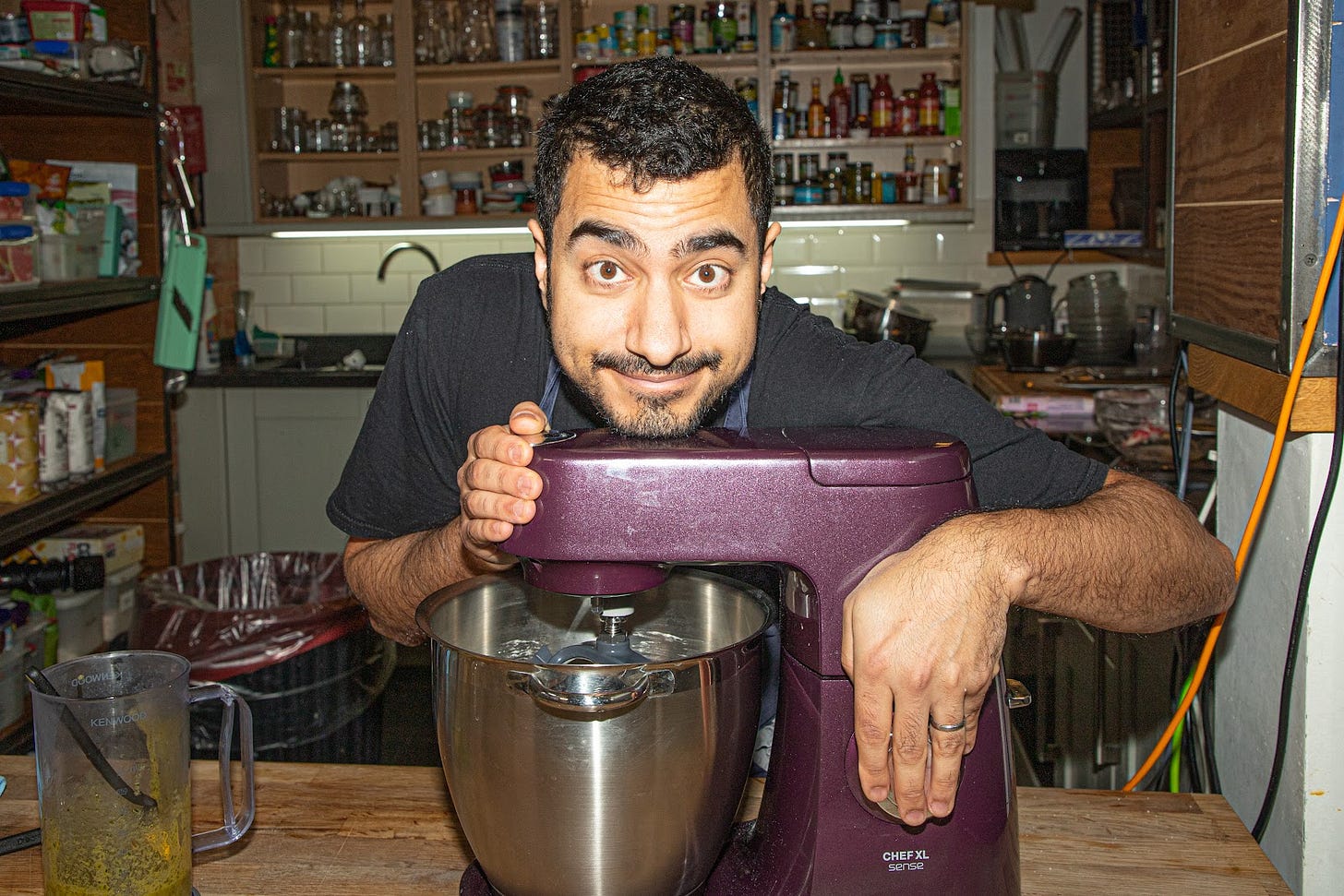
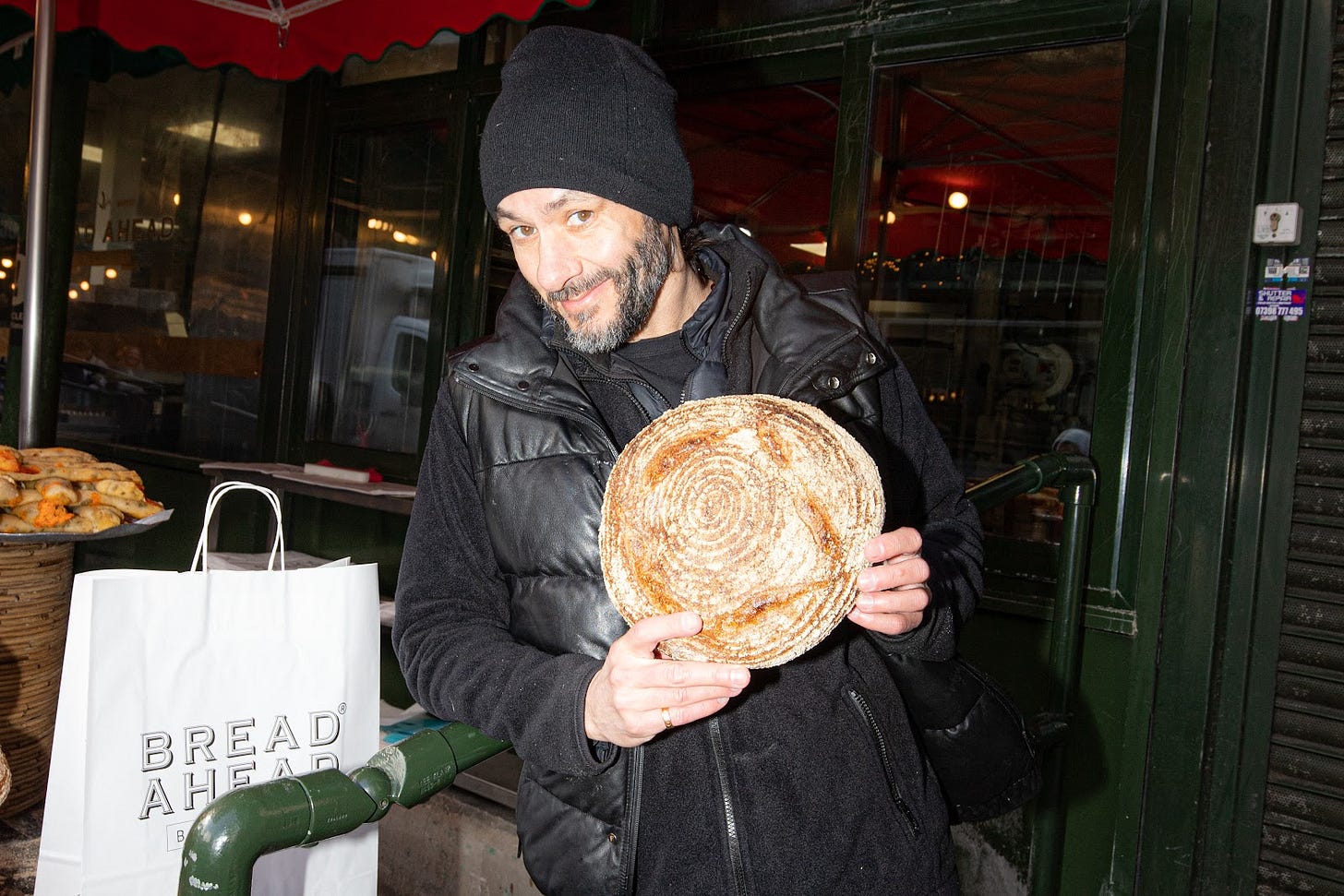
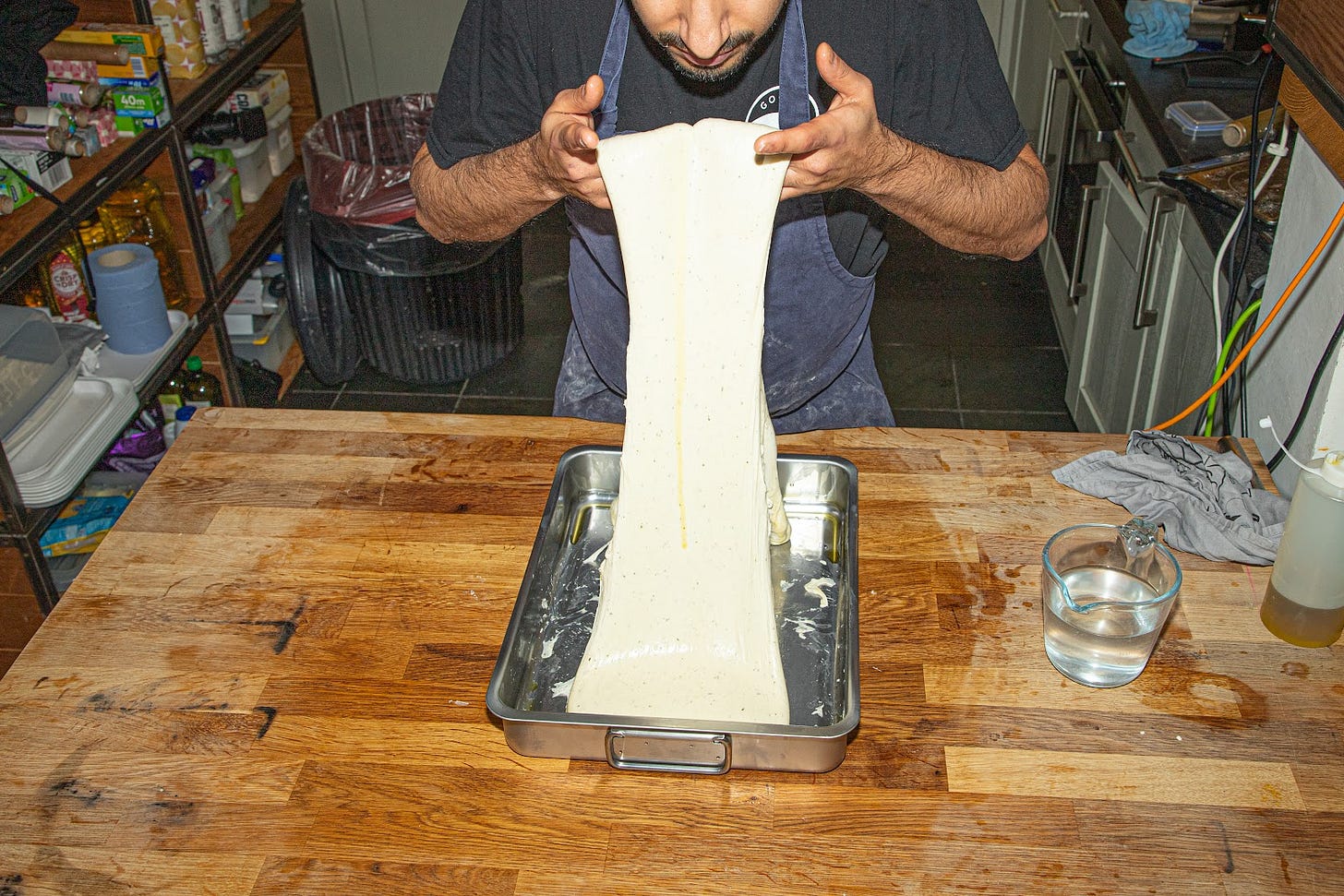
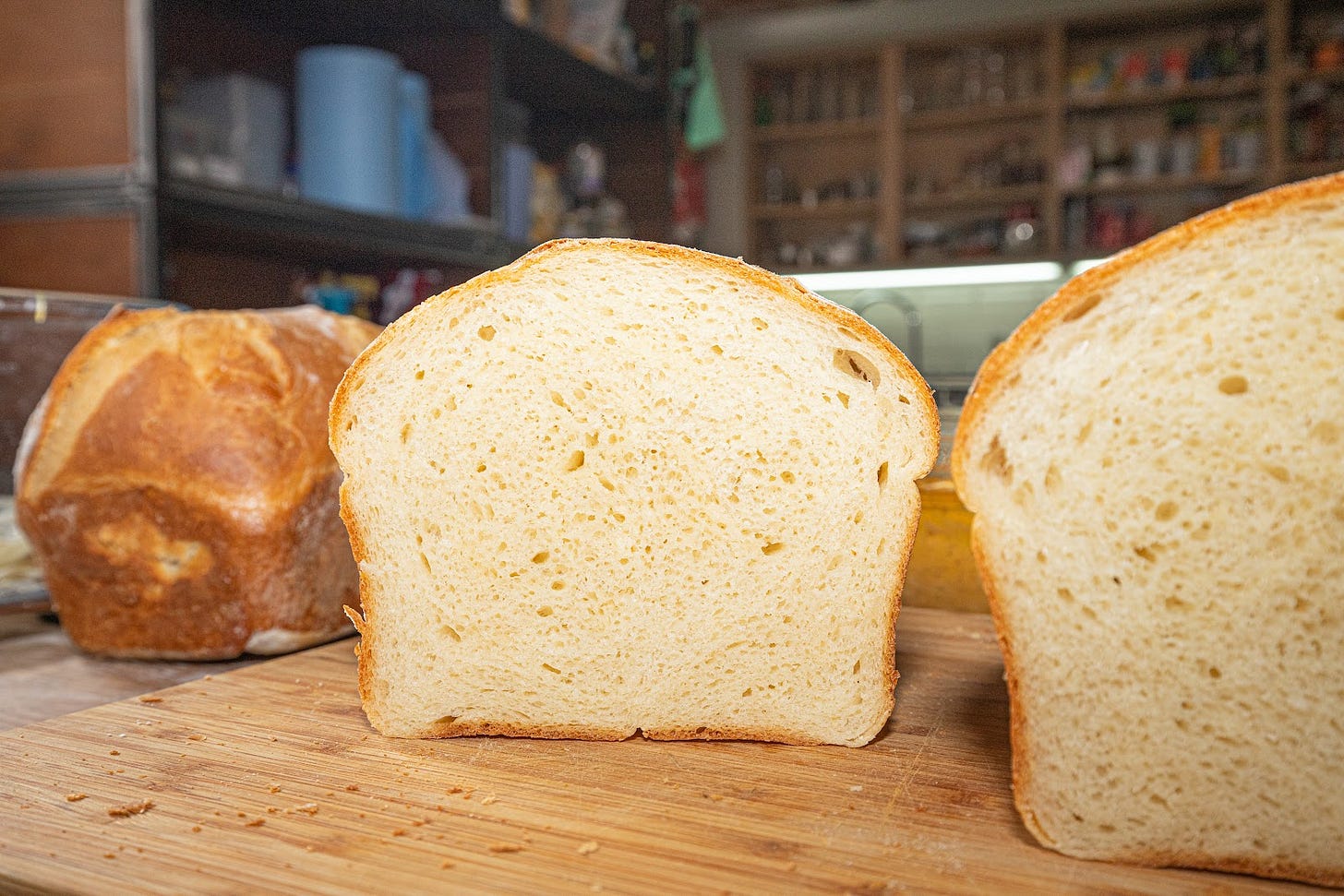
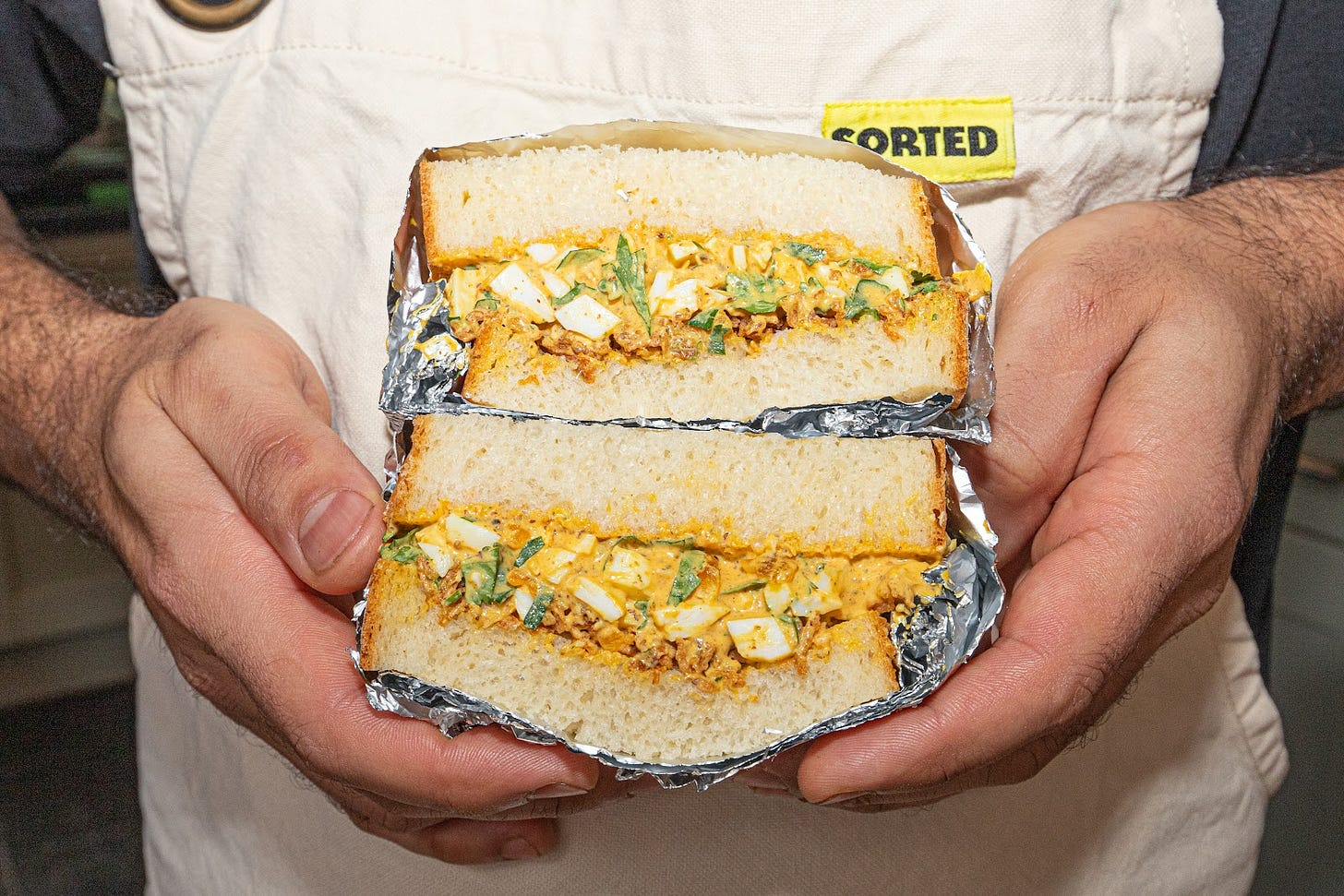
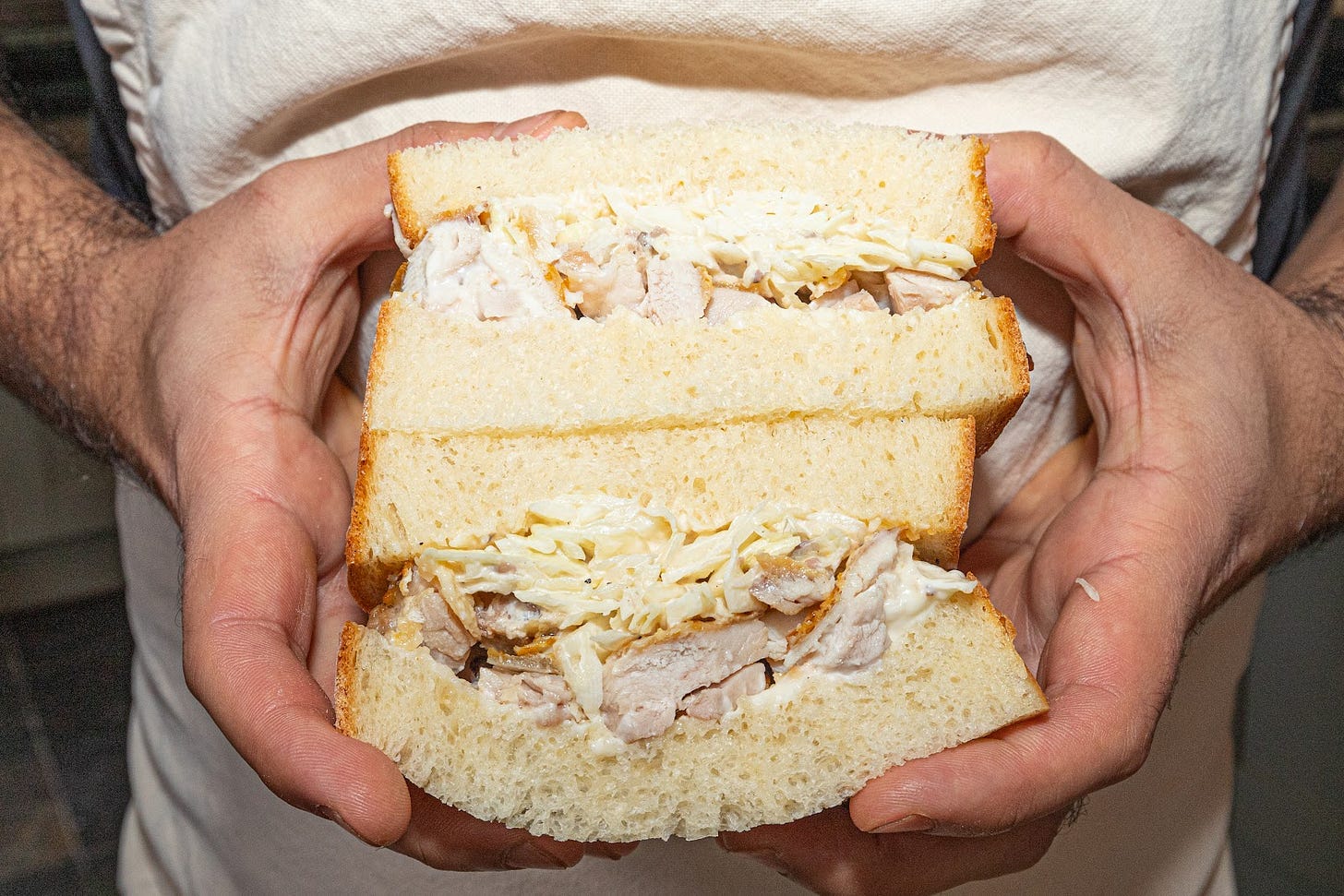

Really enjoyed this newsletter, although I have been baking all of our bread since returning to England after living in France (where there is a decent boulanger on every street corner) there is always something new to learn. Pan crystal will be my next experiment although I was planning on 100% hydration rather than Kush’s 110! Have tried Japanese shokupan but found the results too sweet, using the same technique with less sugar did not give the same amazing texture. Still experimenting to perfect that.
This was my first Sorted newsletter so very much looking forward to future editions. Have been watching the videos for some years.